BT 12022 - Practical 02: Observation of Plant Cell Structures
VerifiedAdded on 2021/10/01
|8
|1580
|121
Practical Assignment
AI Summary
This practical assignment, BT 12022 Practical 02, focuses on the observation of plant cell structures. The objective is to identify and understand the functions of various cell organelles including the cell wall, cytoplasm, nucleus, chloroplast, and middle lamella using a light microscope. The introduction provides an overview of plant cells, their structure, and the key differences between plant and animal cells, highlighting the role of organelles such as chloroplasts and vacuoles. The assignment includes a labeled diagram of a plant cell and detailed descriptions of various organelles, including the cell wall, chloroplasts, vacuoles, mitochondria, Golgi bodies, nucleus, ribosomes, endoplasmic reticulum, cytoplasm, and lysosomes. Each organelle's structure and function are thoroughly explained, emphasizing their roles in photosynthesis, energy production, protein synthesis, and overall cell metabolism. The document serves as a comprehensive guide to understanding plant cell biology.
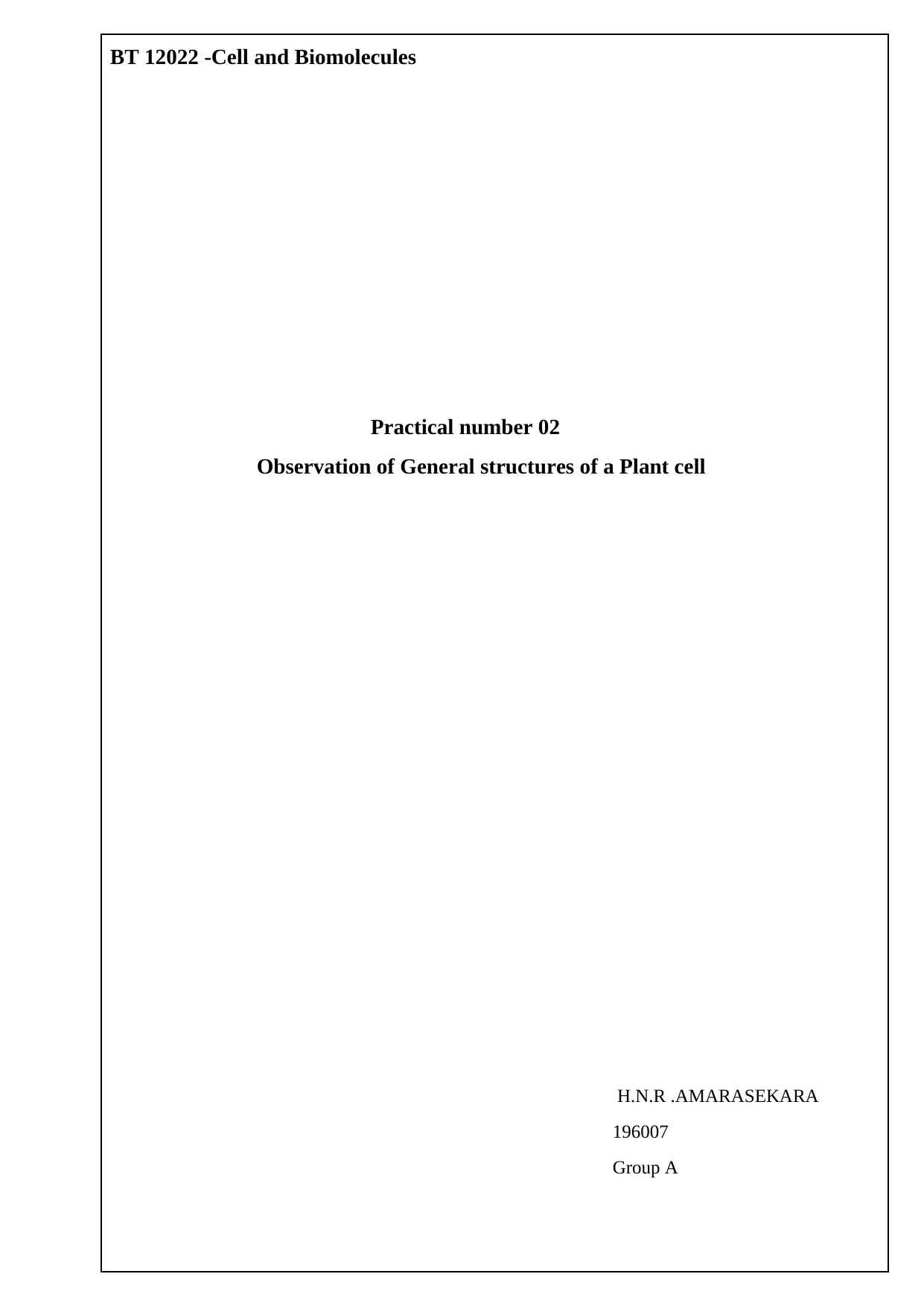
BT 12022 -Cell and Biomolecules
Practical number 02
Observation of General structures of a Plant cell
H.N.R .AMARASEKARA
196007
Group A
Practical number 02
Observation of General structures of a Plant cell
H.N.R .AMARASEKARA
196007
Group A
Paraphrase This Document
Need a fresh take? Get an instant paraphrase of this document with our AI Paraphraser
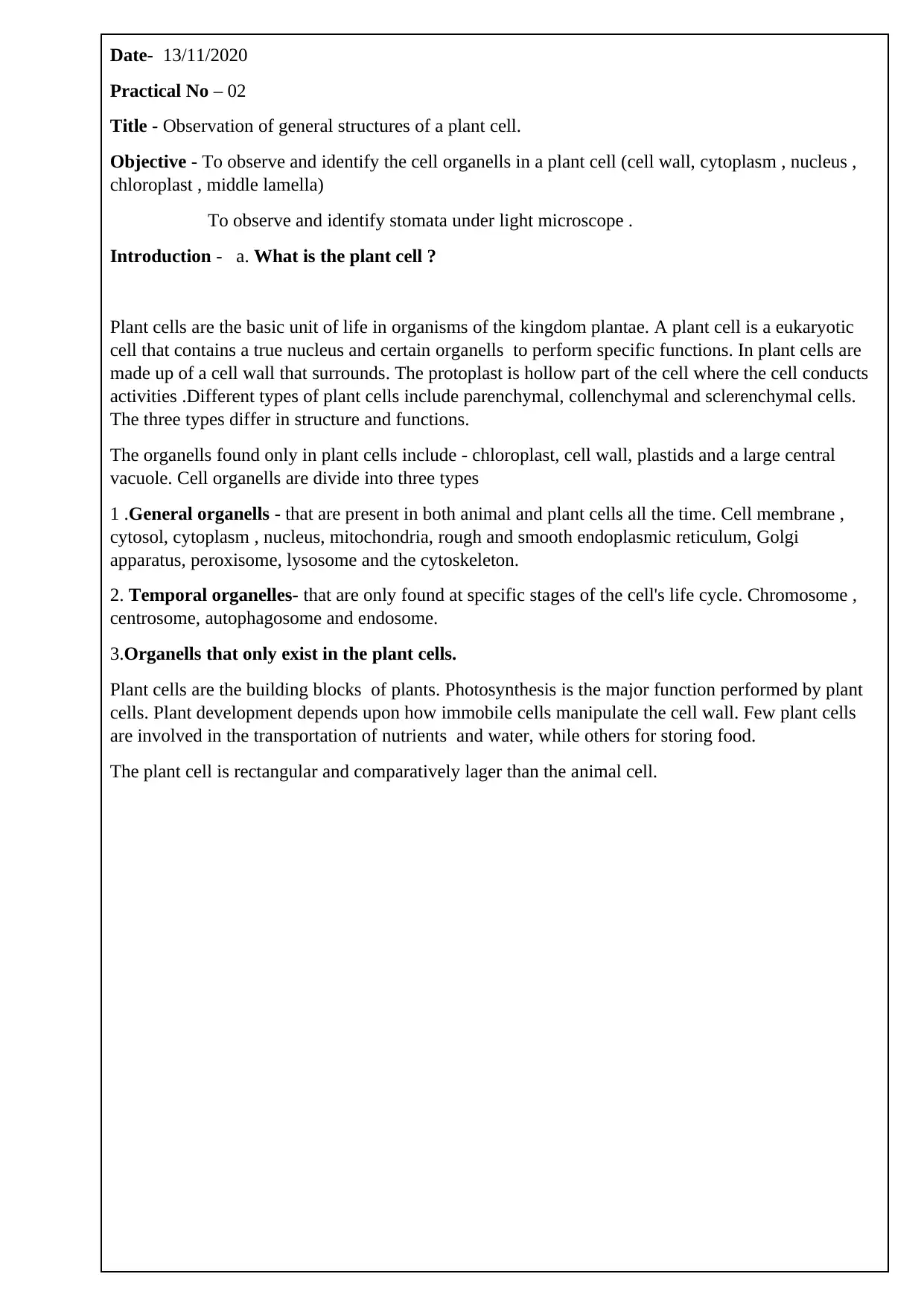
Date- 13/11/2020
Practical No – 02
Title - Observation of general structures of a plant cell.
Objective - To observe and identify the cell organells in a plant cell (cell wall, cytoplasm , nucleus ,
chloroplast , middle lamella)
To observe and identify stomata under light microscope .
Introduction - a. What is the plant cell ?
Plant cells are the basic unit of life in organisms of the kingdom plantae. A plant cell is a eukaryotic
cell that contains a true nucleus and certain organells to perform specific functions. In plant cells are
made up of a cell wall that surrounds. The protoplast is hollow part of the cell where the cell conducts
activities .Different types of plant cells include parenchymal, collenchymal and sclerenchymal cells.
The three types differ in structure and functions.
The organells found only in plant cells include - chloroplast, cell wall, plastids and a large central
vacuole. Cell organells are divide into three types
1 .General organells - that are present in both animal and plant cells all the time. Cell membrane ,
cytosol, cytoplasm , nucleus, mitochondria, rough and smooth endoplasmic reticulum, Golgi
apparatus, peroxisome, lysosome and the cytoskeleton.
2. Temporal organelles- that are only found at specific stages of the cell's life cycle. Chromosome ,
centrosome, autophagosome and endosome.
3.Organells that only exist in the plant cells.
Plant cells are the building blocks of plants. Photosynthesis is the major function performed by plant
cells. Plant development depends upon how immobile cells manipulate the cell wall. Few plant cells
are involved in the transportation of nutrients and water, while others for storing food.
The plant cell is rectangular and comparatively lager than the animal cell.
Practical No – 02
Title - Observation of general structures of a plant cell.
Objective - To observe and identify the cell organells in a plant cell (cell wall, cytoplasm , nucleus ,
chloroplast , middle lamella)
To observe and identify stomata under light microscope .
Introduction - a. What is the plant cell ?
Plant cells are the basic unit of life in organisms of the kingdom plantae. A plant cell is a eukaryotic
cell that contains a true nucleus and certain organells to perform specific functions. In plant cells are
made up of a cell wall that surrounds. The protoplast is hollow part of the cell where the cell conducts
activities .Different types of plant cells include parenchymal, collenchymal and sclerenchymal cells.
The three types differ in structure and functions.
The organells found only in plant cells include - chloroplast, cell wall, plastids and a large central
vacuole. Cell organells are divide into three types
1 .General organells - that are present in both animal and plant cells all the time. Cell membrane ,
cytosol, cytoplasm , nucleus, mitochondria, rough and smooth endoplasmic reticulum, Golgi
apparatus, peroxisome, lysosome and the cytoskeleton.
2. Temporal organelles- that are only found at specific stages of the cell's life cycle. Chromosome ,
centrosome, autophagosome and endosome.
3.Organells that only exist in the plant cells.
Plant cells are the building blocks of plants. Photosynthesis is the major function performed by plant
cells. Plant development depends upon how immobile cells manipulate the cell wall. Few plant cells
are involved in the transportation of nutrients and water, while others for storing food.
The plant cell is rectangular and comparatively lager than the animal cell.
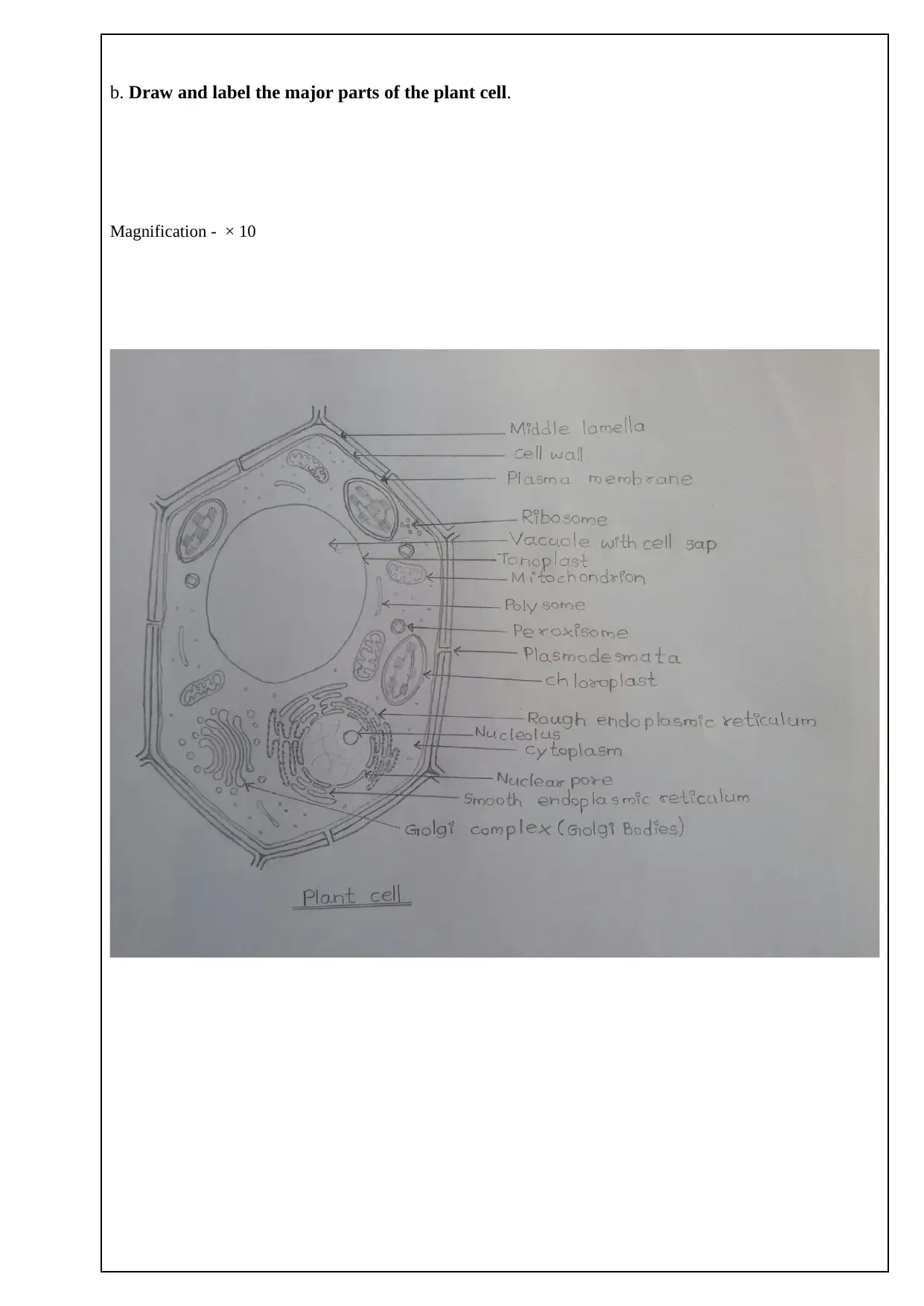
b. Draw and label the major parts of the plant cell.
Magnification - × 10
Magnification - × 10
⊘ This is a preview!⊘
Do you want full access?
Subscribe today to unlock all pages.

Trusted by 1+ million students worldwide
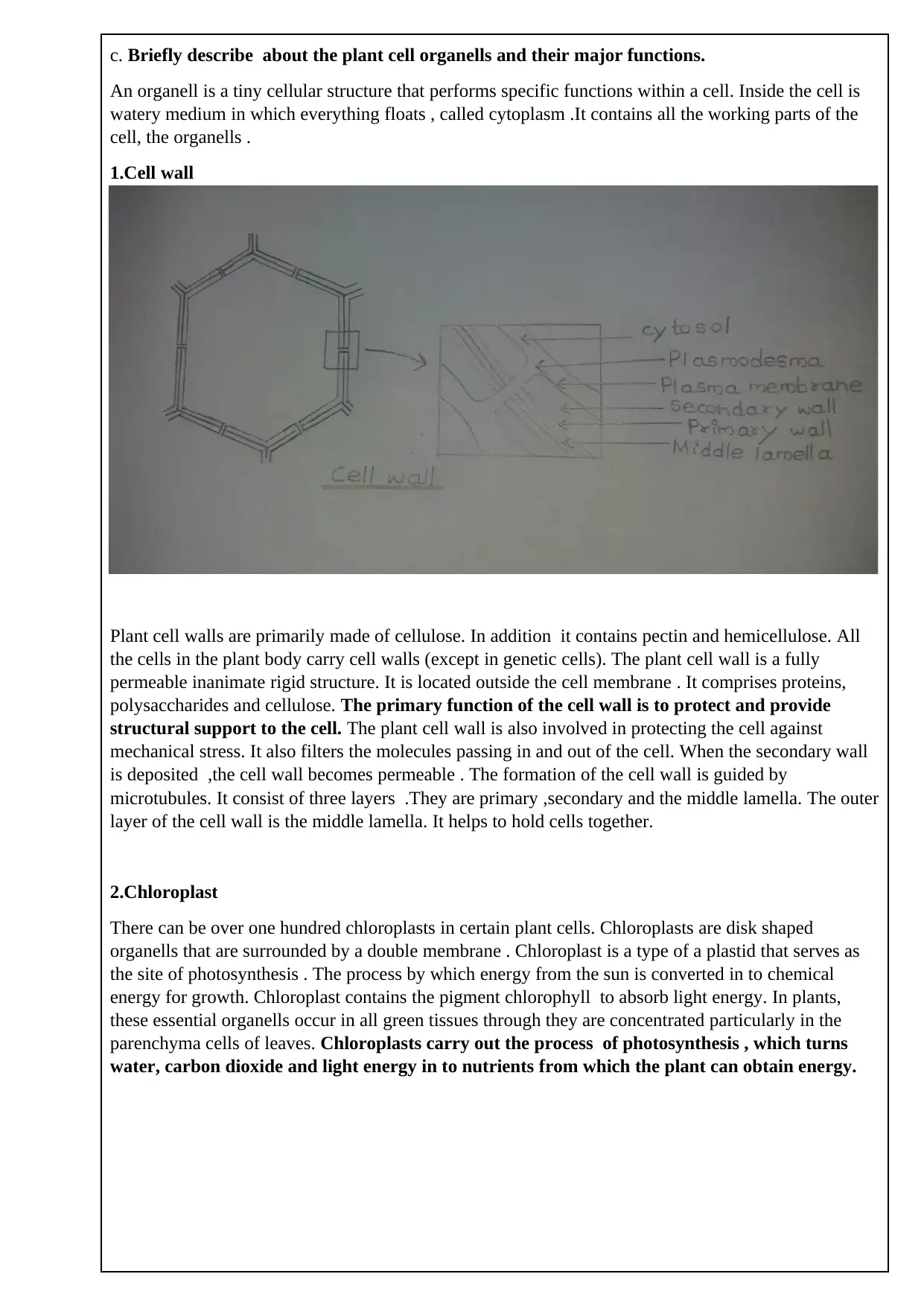
c. Briefly describe about the plant cell organells and their major functions.
An organell is a tiny cellular structure that performs specific functions within a cell. Inside the cell is
watery medium in which everything floats , called cytoplasm .It contains all the working parts of the
cell, the organells .
1.Cell wall
Plant cell walls are primarily made of cellulose. In addition it contains pectin and hemicellulose. All
the cells in the plant body carry cell walls (except in genetic cells). The plant cell wall is a fully
permeable inanimate rigid structure. It is located outside the cell membrane . It comprises proteins,
polysaccharides and cellulose. The primary function of the cell wall is to protect and provide
structural support to the cell. The plant cell wall is also involved in protecting the cell against
mechanical stress. It also filters the molecules passing in and out of the cell. When the secondary wall
is deposited ,the cell wall becomes permeable . The formation of the cell wall is guided by
microtubules. It consist of three layers .They are primary ,secondary and the middle lamella. The outer
layer of the cell wall is the middle lamella. It helps to hold cells together.
2.Chloroplast
There can be over one hundred chloroplasts in certain plant cells. Chloroplasts are disk shaped
organells that are surrounded by a double membrane . Chloroplast is a type of a plastid that serves as
the site of photosynthesis . The process by which energy from the sun is converted in to chemical
energy for growth. Chloroplast contains the pigment chlorophyll to absorb light energy. In plants,
these essential organells occur in all green tissues through they are concentrated particularly in the
parenchyma cells of leaves. Chloroplasts carry out the process of photosynthesis , which turns
water, carbon dioxide and light energy in to nutrients from which the plant can obtain energy.
An organell is a tiny cellular structure that performs specific functions within a cell. Inside the cell is
watery medium in which everything floats , called cytoplasm .It contains all the working parts of the
cell, the organells .
1.Cell wall
Plant cell walls are primarily made of cellulose. In addition it contains pectin and hemicellulose. All
the cells in the plant body carry cell walls (except in genetic cells). The plant cell wall is a fully
permeable inanimate rigid structure. It is located outside the cell membrane . It comprises proteins,
polysaccharides and cellulose. The primary function of the cell wall is to protect and provide
structural support to the cell. The plant cell wall is also involved in protecting the cell against
mechanical stress. It also filters the molecules passing in and out of the cell. When the secondary wall
is deposited ,the cell wall becomes permeable . The formation of the cell wall is guided by
microtubules. It consist of three layers .They are primary ,secondary and the middle lamella. The outer
layer of the cell wall is the middle lamella. It helps to hold cells together.
2.Chloroplast
There can be over one hundred chloroplasts in certain plant cells. Chloroplasts are disk shaped
organells that are surrounded by a double membrane . Chloroplast is a type of a plastid that serves as
the site of photosynthesis . The process by which energy from the sun is converted in to chemical
energy for growth. Chloroplast contains the pigment chlorophyll to absorb light energy. In plants,
these essential organells occur in all green tissues through they are concentrated particularly in the
parenchyma cells of leaves. Chloroplasts carry out the process of photosynthesis , which turns
water, carbon dioxide and light energy in to nutrients from which the plant can obtain energy.
Paraphrase This Document
Need a fresh take? Get an instant paraphrase of this document with our AI Paraphraser
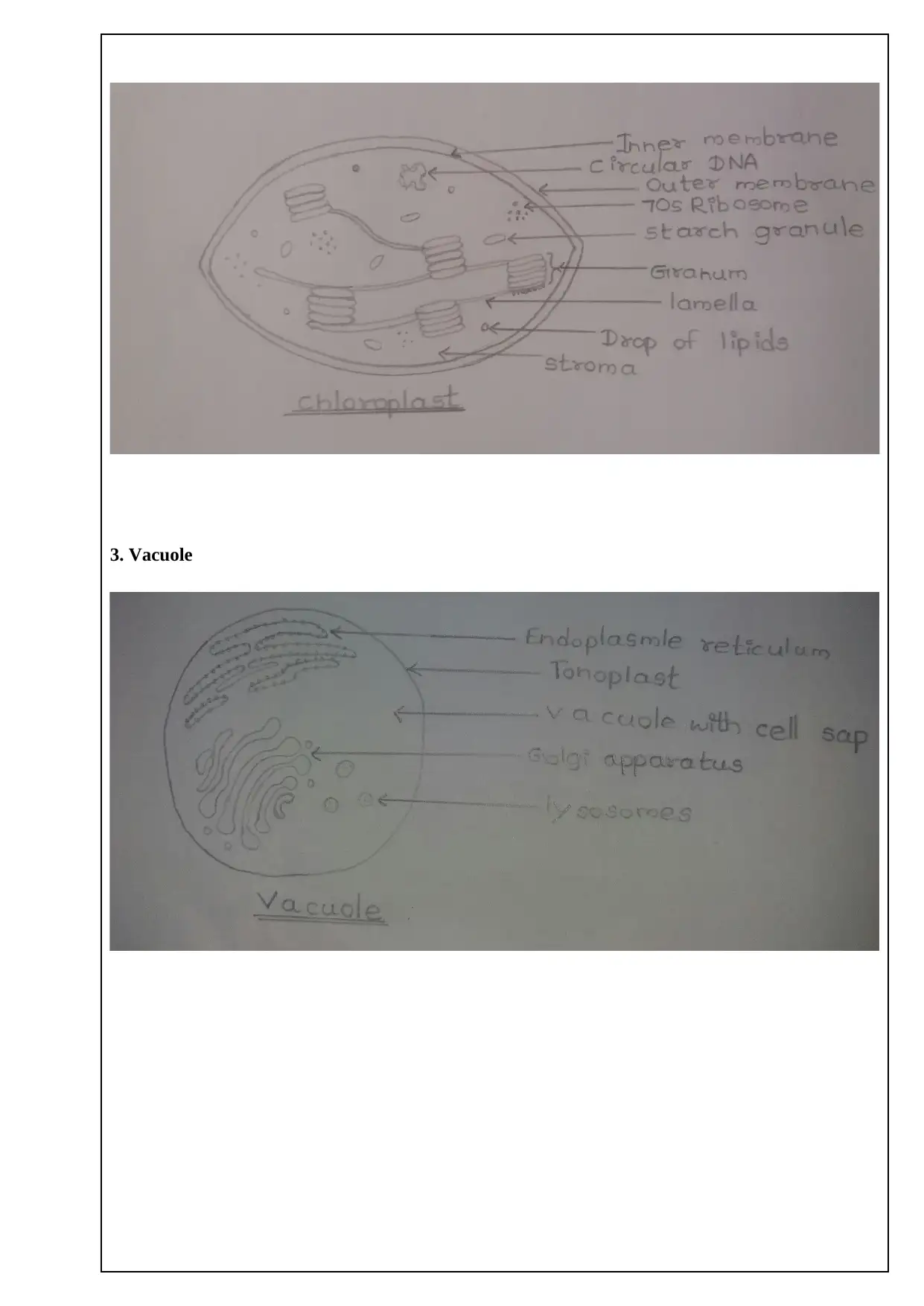
3. Vacuole
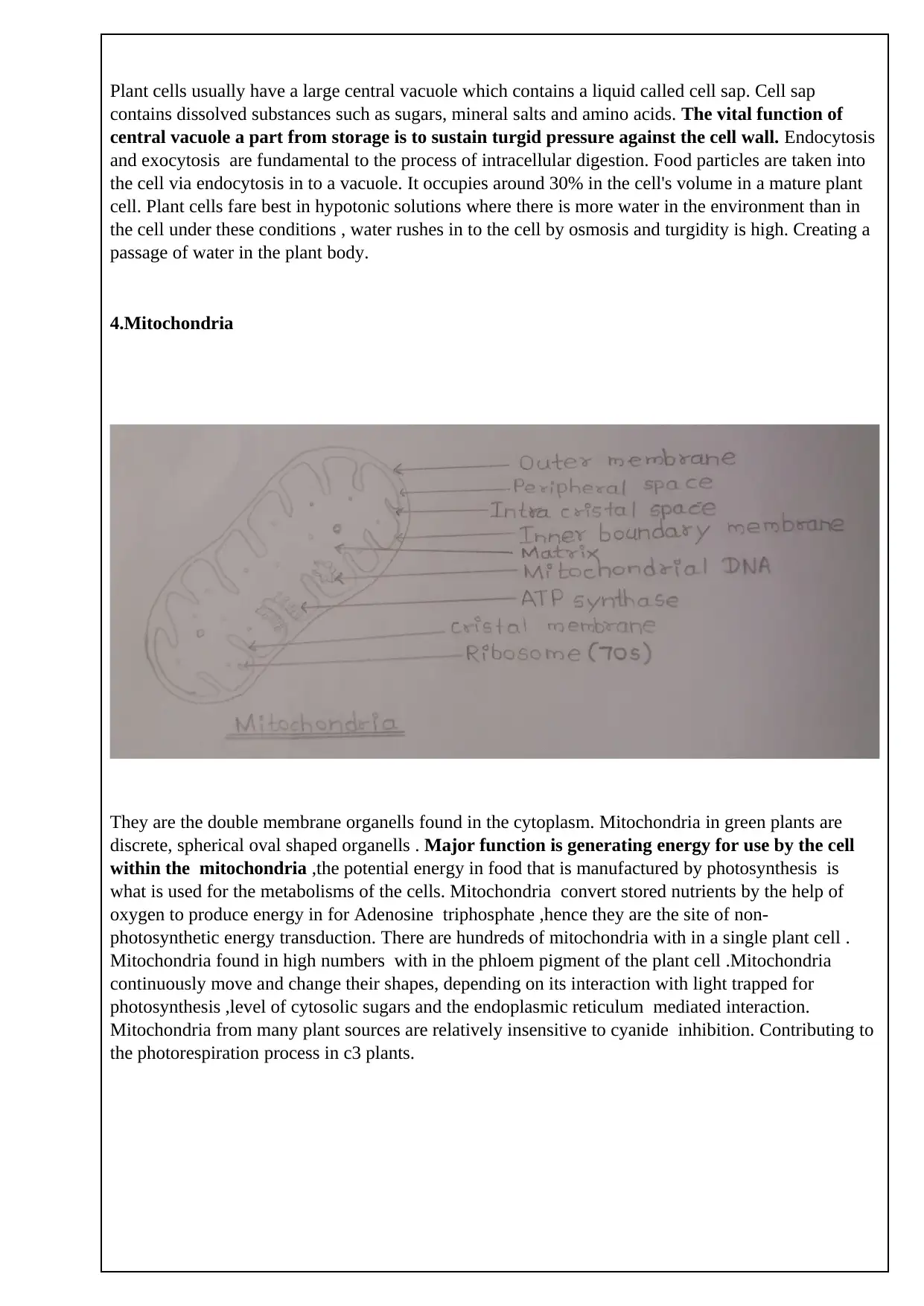
Plant cells usually have a large central vacuole which contains a liquid called cell sap. Cell sap
contains dissolved substances such as sugars, mineral salts and amino acids. The vital function of
central vacuole a part from storage is to sustain turgid pressure against the cell wall. Endocytosis
and exocytosis are fundamental to the process of intracellular digestion. Food particles are taken into
the cell via endocytosis in to a vacuole. It occupies around 30% in the cell's volume in a mature plant
cell. Plant cells fare best in hypotonic solutions where there is more water in the environment than in
the cell under these conditions , water rushes in to the cell by osmosis and turgidity is high. Creating a
passage of water in the plant body.
4.Mitochondria
They are the double membrane organells found in the cytoplasm. Mitochondria in green plants are
discrete, spherical oval shaped organells . Major function is generating energy for use by the cell
within the mitochondria ,the potential energy in food that is manufactured by photosynthesis is
what is used for the metabolisms of the cells. Mitochondria convert stored nutrients by the help of
oxygen to produce energy in for Adenosine triphosphate ,hence they are the site of non-
photosynthetic energy transduction. There are hundreds of mitochondria with in a single plant cell .
Mitochondria found in high numbers with in the phloem pigment of the plant cell .Mitochondria
continuously move and change their shapes, depending on its interaction with light trapped for
photosynthesis ,level of cytosolic sugars and the endoplasmic reticulum mediated interaction.
Mitochondria from many plant sources are relatively insensitive to cyanide inhibition. Contributing to
the photorespiration process in c3 plants.
contains dissolved substances such as sugars, mineral salts and amino acids. The vital function of
central vacuole a part from storage is to sustain turgid pressure against the cell wall. Endocytosis
and exocytosis are fundamental to the process of intracellular digestion. Food particles are taken into
the cell via endocytosis in to a vacuole. It occupies around 30% in the cell's volume in a mature plant
cell. Plant cells fare best in hypotonic solutions where there is more water in the environment than in
the cell under these conditions , water rushes in to the cell by osmosis and turgidity is high. Creating a
passage of water in the plant body.
4.Mitochondria
They are the double membrane organells found in the cytoplasm. Mitochondria in green plants are
discrete, spherical oval shaped organells . Major function is generating energy for use by the cell
within the mitochondria ,the potential energy in food that is manufactured by photosynthesis is
what is used for the metabolisms of the cells. Mitochondria convert stored nutrients by the help of
oxygen to produce energy in for Adenosine triphosphate ,hence they are the site of non-
photosynthetic energy transduction. There are hundreds of mitochondria with in a single plant cell .
Mitochondria found in high numbers with in the phloem pigment of the plant cell .Mitochondria
continuously move and change their shapes, depending on its interaction with light trapped for
photosynthesis ,level of cytosolic sugars and the endoplasmic reticulum mediated interaction.
Mitochondria from many plant sources are relatively insensitive to cyanide inhibition. Contributing to
the photorespiration process in c3 plants.
⊘ This is a preview!⊘
Do you want full access?
Subscribe today to unlock all pages.

Trusted by 1+ million students worldwide
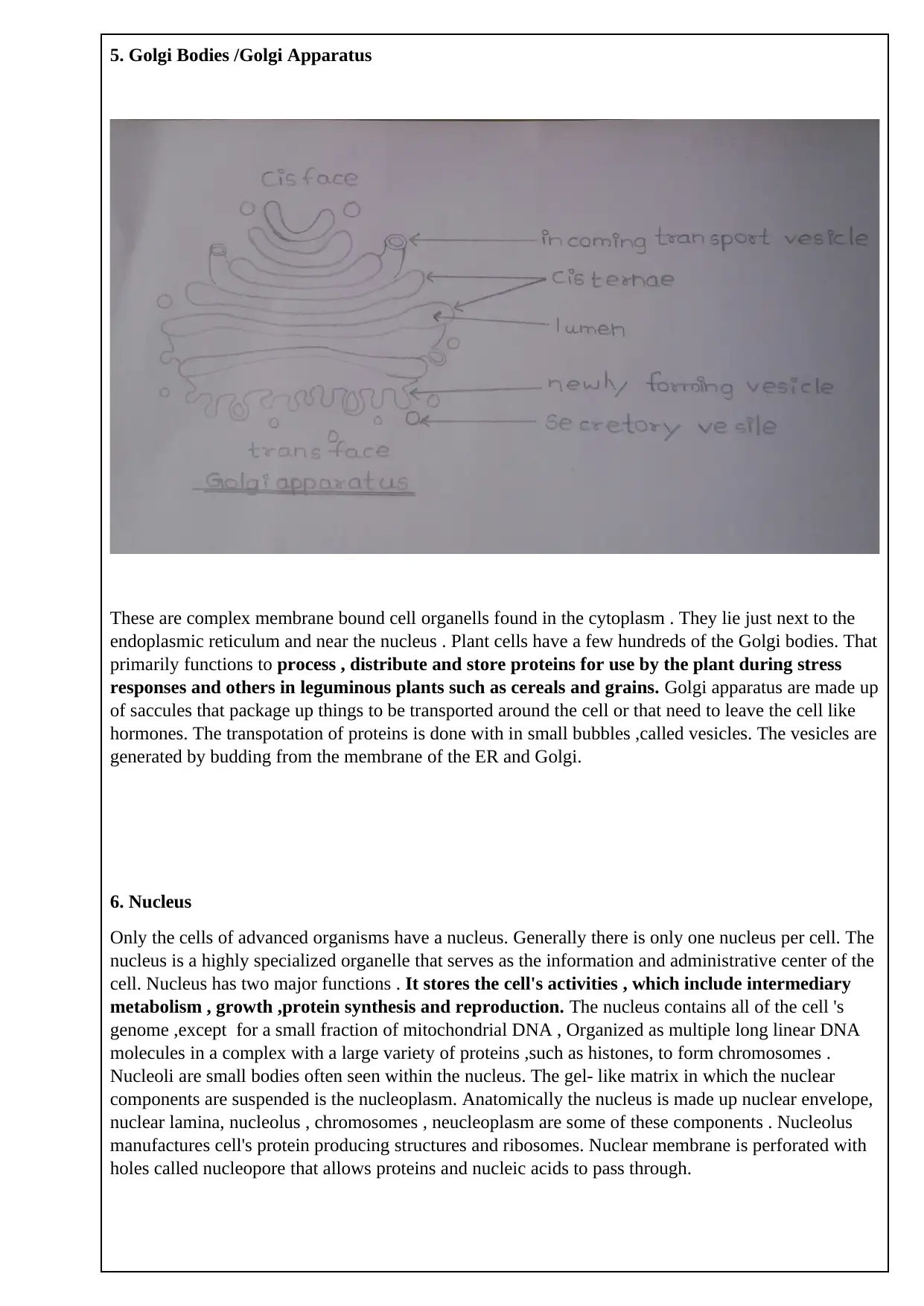
5. Golgi Bodies /Golgi Apparatus
These are complex membrane bound cell organells found in the cytoplasm . They lie just next to the
endoplasmic reticulum and near the nucleus . Plant cells have a few hundreds of the Golgi bodies. That
primarily functions to process , distribute and store proteins for use by the plant during stress
responses and others in leguminous plants such as cereals and grains. Golgi apparatus are made up
of saccules that package up things to be transported around the cell or that need to leave the cell like
hormones. The transpotation of proteins is done with in small bubbles ,called vesicles. The vesicles are
generated by budding from the membrane of the ER and Golgi.
6. Nucleus
Only the cells of advanced organisms have a nucleus. Generally there is only one nucleus per cell. The
nucleus is a highly specialized organelle that serves as the information and administrative center of the
cell. Nucleus has two major functions . It stores the cell's activities , which include intermediary
metabolism , growth ,protein synthesis and reproduction. The nucleus contains all of the cell 's
genome ,except for a small fraction of mitochondrial DNA , Organized as multiple long linear DNA
molecules in a complex with a large variety of proteins ,such as histones, to form chromosomes .
Nucleoli are small bodies often seen within the nucleus. The gel- like matrix in which the nuclear
components are suspended is the nucleoplasm. Anatomically the nucleus is made up nuclear envelope,
nuclear lamina, nucleolus , chromosomes , neucleoplasm are some of these components . Nucleolus
manufactures cell's protein producing structures and ribosomes. Nuclear membrane is perforated with
holes called nucleopore that allows proteins and nucleic acids to pass through.
These are complex membrane bound cell organells found in the cytoplasm . They lie just next to the
endoplasmic reticulum and near the nucleus . Plant cells have a few hundreds of the Golgi bodies. That
primarily functions to process , distribute and store proteins for use by the plant during stress
responses and others in leguminous plants such as cereals and grains. Golgi apparatus are made up
of saccules that package up things to be transported around the cell or that need to leave the cell like
hormones. The transpotation of proteins is done with in small bubbles ,called vesicles. The vesicles are
generated by budding from the membrane of the ER and Golgi.
6. Nucleus
Only the cells of advanced organisms have a nucleus. Generally there is only one nucleus per cell. The
nucleus is a highly specialized organelle that serves as the information and administrative center of the
cell. Nucleus has two major functions . It stores the cell's activities , which include intermediary
metabolism , growth ,protein synthesis and reproduction. The nucleus contains all of the cell 's
genome ,except for a small fraction of mitochondrial DNA , Organized as multiple long linear DNA
molecules in a complex with a large variety of proteins ,such as histones, to form chromosomes .
Nucleoli are small bodies often seen within the nucleus. The gel- like matrix in which the nuclear
components are suspended is the nucleoplasm. Anatomically the nucleus is made up nuclear envelope,
nuclear lamina, nucleolus , chromosomes , neucleoplasm are some of these components . Nucleolus
manufactures cell's protein producing structures and ribosomes. Nuclear membrane is perforated with
holes called nucleopore that allows proteins and nucleic acids to pass through.
Paraphrase This Document
Need a fresh take? Get an instant paraphrase of this document with our AI Paraphraser
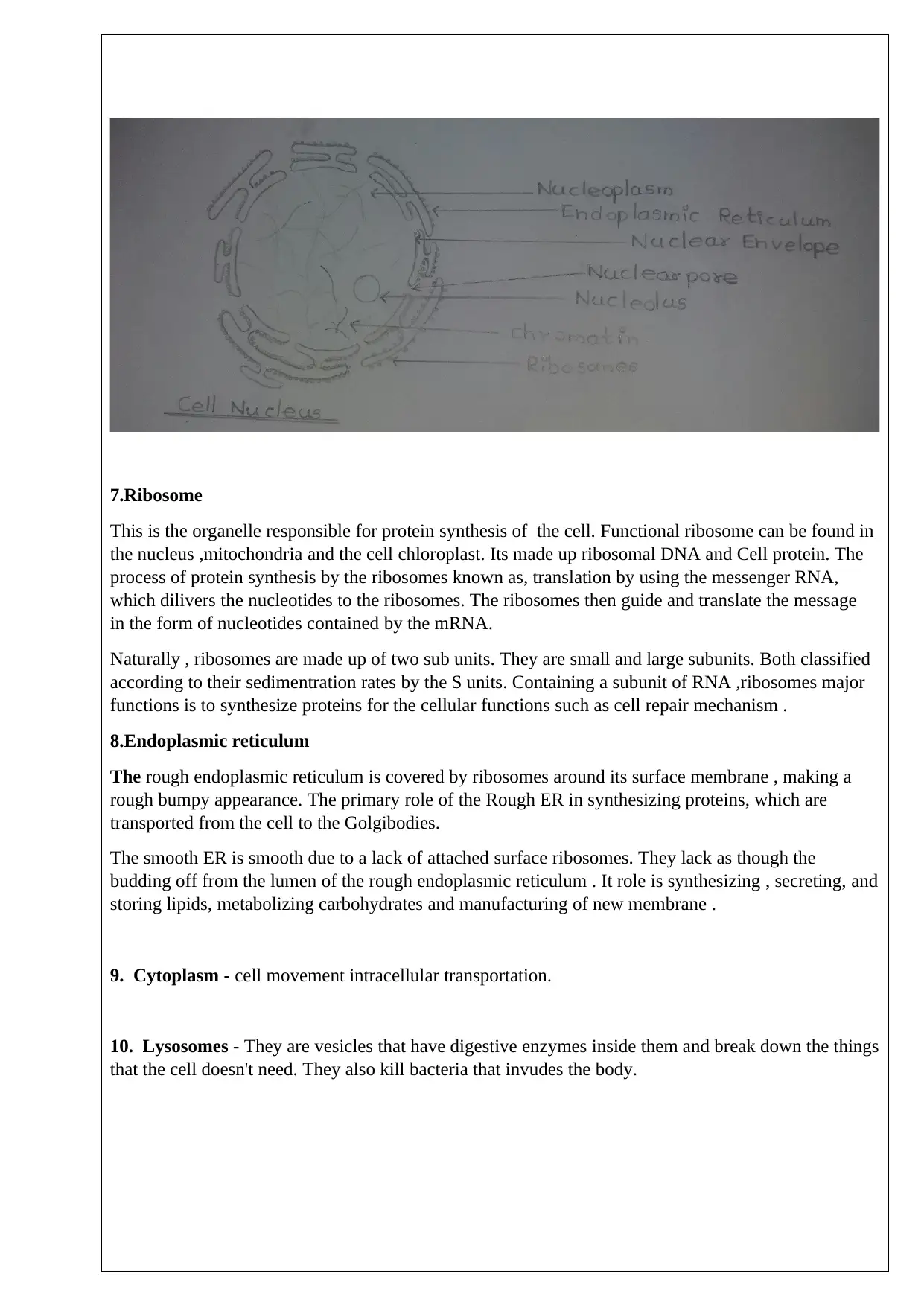
7.Ribosome
This is the organelle responsible for protein synthesis of the cell. Functional ribosome can be found in
the nucleus ,mitochondria and the cell chloroplast. Its made up ribosomal DNA and Cell protein. The
process of protein synthesis by the ribosomes known as, translation by using the messenger RNA,
which dilivers the nucleotides to the ribosomes. The ribosomes then guide and translate the message
in the form of nucleotides contained by the mRNA.
Naturally , ribosomes are made up of two sub units. They are small and large subunits. Both classified
according to their sedimentration rates by the S units. Containing a subunit of RNA ,ribosomes major
functions is to synthesize proteins for the cellular functions such as cell repair mechanism .
8.Endoplasmic reticulum
The rough endoplasmic reticulum is covered by ribosomes around its surface membrane , making a
rough bumpy appearance. The primary role of the Rough ER in synthesizing proteins, which are
transported from the cell to the Golgibodies.
The smooth ER is smooth due to a lack of attached surface ribosomes. They lack as though the
budding off from the lumen of the rough endoplasmic reticulum . It role is synthesizing , secreting, and
storing lipids, metabolizing carbohydrates and manufacturing of new membrane .
9. Cytoplasm - cell movement intracellular transportation.
10. Lysosomes - They are vesicles that have digestive enzymes inside them and break down the things
that the cell doesn't need. They also kill bacteria that invudes the body.
This is the organelle responsible for protein synthesis of the cell. Functional ribosome can be found in
the nucleus ,mitochondria and the cell chloroplast. Its made up ribosomal DNA and Cell protein. The
process of protein synthesis by the ribosomes known as, translation by using the messenger RNA,
which dilivers the nucleotides to the ribosomes. The ribosomes then guide and translate the message
in the form of nucleotides contained by the mRNA.
Naturally , ribosomes are made up of two sub units. They are small and large subunits. Both classified
according to their sedimentration rates by the S units. Containing a subunit of RNA ,ribosomes major
functions is to synthesize proteins for the cellular functions such as cell repair mechanism .
8.Endoplasmic reticulum
The rough endoplasmic reticulum is covered by ribosomes around its surface membrane , making a
rough bumpy appearance. The primary role of the Rough ER in synthesizing proteins, which are
transported from the cell to the Golgibodies.
The smooth ER is smooth due to a lack of attached surface ribosomes. They lack as though the
budding off from the lumen of the rough endoplasmic reticulum . It role is synthesizing , secreting, and
storing lipids, metabolizing carbohydrates and manufacturing of new membrane .
9. Cytoplasm - cell movement intracellular transportation.
10. Lysosomes - They are vesicles that have digestive enzymes inside them and break down the things
that the cell doesn't need. They also kill bacteria that invudes the body.
1 out of 8
Related Documents
Your All-in-One AI-Powered Toolkit for Academic Success.
+13062052269
info@desklib.com
Available 24*7 on WhatsApp / Email
![[object Object]](/_next/static/media/star-bottom.7253800d.svg)
Unlock your academic potential
Copyright © 2020–2025 A2Z Services. All Rights Reserved. Developed and managed by ZUCOL.





